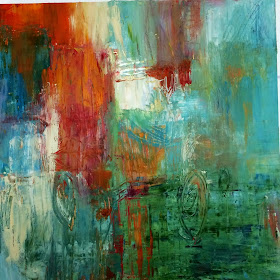Oil and Cold Wax, unlike encaustic wax is not heated, or melted and does not have to be fused between each layer. Although it does have to dry to the touch between layers. Basically oil paint is mixed with a wax medium with a palate knife to make the paint thicker and more textured.
A wonderful abstract artist that works in cold wax and one that I admire is Rebecca Crowell. Her site and blog oilandwax.ning.com has a wealth of information, and I highly recommend it if you are interested in learning about it.
I started right in and have done a few artworks to share. It is a very forgiving medium as you can paint over a painting a thousand times. Which for me is somewhat of an issue as I never know when a painting is finished.
 |
| Cocoon 12" X 12" |
.
This attempt has much more paint, and it really was fun to scribble on the surface. I pushed a piece of plastic mesh from a grocery bag of oranges into the surface in the upper left and middle right. It makes a very nice diamond texture. On the right side I pushed a gold oil pigment stick into the pattern when it was dry.
 |
| Falling 6" X 6" |
These 2 paintings have thin coatings of wax and oil, then I let them dry well, and went back into them with oil pigment sticks and turpentine. I am enjoying working with oil and Dorland's wax medium and I plan to keep experimenting and will share work as I go along. Both are painted on 12" X 12" cradled board.


